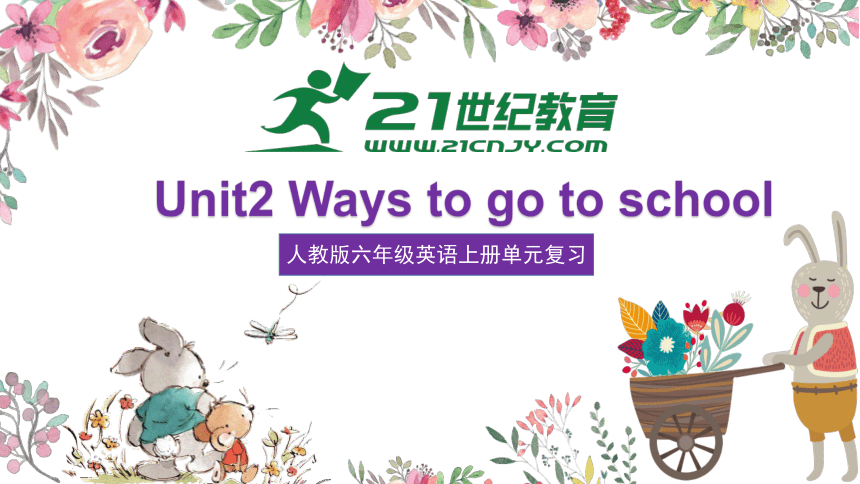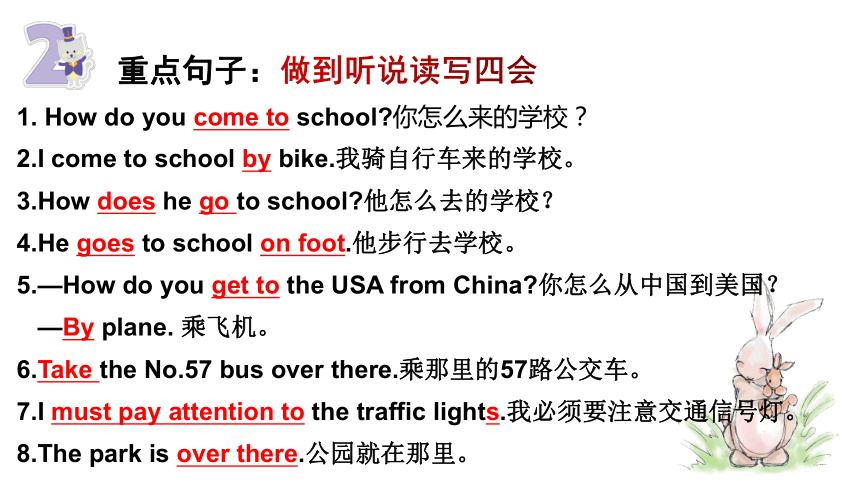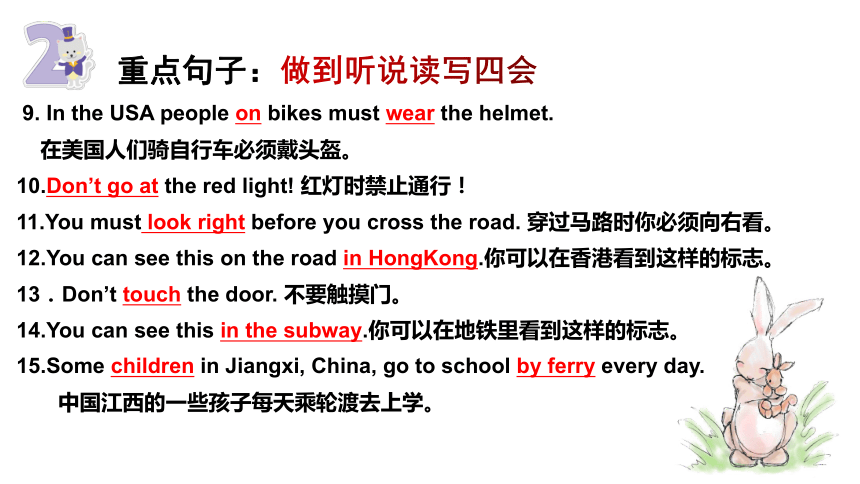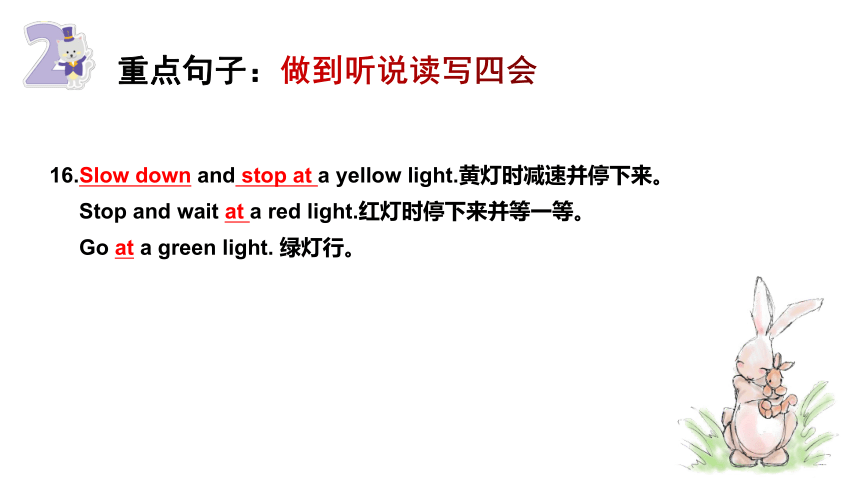人教PEP版英语六年级上册Unit2 Ways to go to school单元复习课件
文档属性
| 名称 | 人教PEP版英语六年级上册Unit2 Ways to go to school单元复习课件 |  | |
| 格式 | pptx | ||
| 文件大小 | 3.3MB | ||
| 资源类型 | 试卷 | ||
| 版本资源 | 人教版(PEP) | ||
| 科目 | 英语 | ||
| 更新时间 | 2022-10-13 17:56:45 | ||
图片预览






文档简介
(共12张PPT)
Unit2 Ways to go to school
人教版六年级英语上册单元复习
重点单词:做到听说读写四会
on foot 步行 early 早到的
by bus 乘公共汽车 helmet 头盔
by subway 乘地铁 must 必须
by taxi 乘出租车 wear 穿;戴
by plane 乘飞机 pay attention to 注意
by ship 乘船 traffic lights 交通信号灯
by train 乘火车 fast 快的
by bike 骑自行车 wait 等待
by ferry 乘轮渡 Mrs 夫人
by sled 乘雪橇 stop 停止
slow down 慢下来 减速
重点句子:做到听说读写四会
1. How do you come to school 你怎么来的学校?
2.I come to school by bike.我骑自行车来的学校。
3.How does he go to school 他怎么去的学校?
4.He goes to school on foot.他步行去学校。
5.—How do you get to the USA from China 你怎么从中国到美国?
—By plane. 乘飞机。
6.Take the No.57 bus over there.乘那里的57路公交车。
7.I must pay attention to the traffic lights.我必须要注意交通信号灯。
8.The park is over there.公园就在那里。
重点句子:做到听说读写四会
9. In the USA people on bikes must wear the helmet.
在美国人们骑自行车必须戴头盔。
10.Don’t go at the red light! 红灯时禁止通行!
11.You must look right before you cross the road. 穿过马路时你必须向右看。
12.You can see this on the road in HongKong.你可以在香港看到这样的标志。
13.Don’t touch the door. 不要触摸门。
14.You can see this in the subway.你可以在地铁里看到这样的标志。
15.Some children in Jiangxi, China, go to school by ferry every day.
中国江西的一些孩子每天乘轮渡去上学。
重点句子:做到听说读写四会
16.Slow down and stop at a yellow light.黄灯时减速并停下来。
Stop and wait at a red light.红灯时停下来并等一等。
Go at a green light. 绿灯行。
重点:注意考点
1、Don’t go at the red light
Don’t + 谓语动词原形(两类谓语,be动词谓语和实义动词谓语),意为“不要做某事”;
Don’t play football on the playground
2、You must pay attention to the traffic lights
① must,情态动词,意为“必须”,为①类句子,改为疑问句时把must提到句首即可;改为否定句时,在must后面加not,must not = mustn’t
Must I pay attention to the traffic lights
You mustn’t pay attention to the traffic lights
② pay attention to,固定词组,意为“注意......”;
Please pay attention to that active student
重点:注意考点
3、How do you go to school?
How,特殊疑问副词,意为“如何,怎样”,可以用来询问做某事的方式、方法或手段等;go to + 地点,意为“去到......”;
I go to school on foot → How do you go to school?
How do you come to school ,come,动词,意为“来”,come to+地点,意为“来到某地”;
I come to school by bike → How do you come to school?
4、by bike,by bus,by train,by plane
by + 交通工具 为介词短语,介词短语都是放在句末的
I get up at six o’clock
They play basketball on the playground
重点:注意考点
5、Is this your bike?
this,指示代词,意为“这个”;
指示代词:
距离近的 距离远的
单数 This(这个) That(那个)
复数 These(这些) Those(那些)
单数类的指示代词和is搭配使用,复数类的指示代词和are搭配使用;
重点:注意考点
6、I often go to work by subway
often,频率副词,意为“经常”,一般放在be动词谓语后面或者实义动词谓语前面;
例如:She is often dressed in yellow skirt
You often play sports in the morning.
7、so many pictures of bikes!
so many,意为“许多”,so many + 可数名词复数
so much,也意为“许多”,so much + 不可数名词
不可数名词:①液体类:water、cola、coffee、tea、milk、juice等
②肉类:fish、mutton、pork、chicken、beef等
③bread ,rice
重点:注意考点
8、pictures of bikes
...of...,名词所有格,意为...的...,先翻译后面再译前面;
名词所有格的构造方法:
①、当“的”字前面的名词后无s,加“’s”,有s加“ ’;分别拥有分别加,共同拥有加后面。
The teacher’s desk Students’ desk
Lily’s and Lucy’s mothers (分别拥有)
Lily and Lusy’s mother (共同拥有)
②、当“的”字前面的名词不是有生命的时候,则在两个名词之间添加“of”,而且翻译成中文时先翻译of后面的再译of前面的;
This is a map of China
Here is a picture of my house
重点:注意考点
9、In Papa Westray,the children go to school by ferry,too
too,意为“也”,用于肯定句,疑问句句末 ; either,也,用于否定句。
also:常位于句中,位于实义动词前面,be动词后面
10、It’s good to see you
It,意为“它”,只是形式主语,真正的主语是后面的to see you,所以这句话的意思是“见到你很高兴”
Nice to meet you = It is nice to meet you
11、Chinese food is so different from British food
be different from,意为“和......不一样”;
be the same as,意为“和......一样”
Thank you!
Unit2 Ways to go to school
人教版六年级英语上册单元复习
重点单词:做到听说读写四会
on foot 步行 early 早到的
by bus 乘公共汽车 helmet 头盔
by subway 乘地铁 must 必须
by taxi 乘出租车 wear 穿;戴
by plane 乘飞机 pay attention to 注意
by ship 乘船 traffic lights 交通信号灯
by train 乘火车 fast 快的
by bike 骑自行车 wait 等待
by ferry 乘轮渡 Mrs 夫人
by sled 乘雪橇 stop 停止
slow down 慢下来 减速
重点句子:做到听说读写四会
1. How do you come to school 你怎么来的学校?
2.I come to school by bike.我骑自行车来的学校。
3.How does he go to school 他怎么去的学校?
4.He goes to school on foot.他步行去学校。
5.—How do you get to the USA from China 你怎么从中国到美国?
—By plane. 乘飞机。
6.Take the No.57 bus over there.乘那里的57路公交车。
7.I must pay attention to the traffic lights.我必须要注意交通信号灯。
8.The park is over there.公园就在那里。
重点句子:做到听说读写四会
9. In the USA people on bikes must wear the helmet.
在美国人们骑自行车必须戴头盔。
10.Don’t go at the red light! 红灯时禁止通行!
11.You must look right before you cross the road. 穿过马路时你必须向右看。
12.You can see this on the road in HongKong.你可以在香港看到这样的标志。
13.Don’t touch the door. 不要触摸门。
14.You can see this in the subway.你可以在地铁里看到这样的标志。
15.Some children in Jiangxi, China, go to school by ferry every day.
中国江西的一些孩子每天乘轮渡去上学。
重点句子:做到听说读写四会
16.Slow down and stop at a yellow light.黄灯时减速并停下来。
Stop and wait at a red light.红灯时停下来并等一等。
Go at a green light. 绿灯行。
重点:注意考点
1、Don’t go at the red light
Don’t + 谓语动词原形(两类谓语,be动词谓语和实义动词谓语),意为“不要做某事”;
Don’t play football on the playground
2、You must pay attention to the traffic lights
① must,情态动词,意为“必须”,为①类句子,改为疑问句时把must提到句首即可;改为否定句时,在must后面加not,must not = mustn’t
Must I pay attention to the traffic lights
You mustn’t pay attention to the traffic lights
② pay attention to,固定词组,意为“注意......”;
Please pay attention to that active student
重点:注意考点
3、How do you go to school?
How,特殊疑问副词,意为“如何,怎样”,可以用来询问做某事的方式、方法或手段等;go to + 地点,意为“去到......”;
I go to school on foot → How do you go to school?
How do you come to school ,come,动词,意为“来”,come to+地点,意为“来到某地”;
I come to school by bike → How do you come to school?
4、by bike,by bus,by train,by plane
by + 交通工具 为介词短语,介词短语都是放在句末的
I get up at six o’clock
They play basketball on the playground
重点:注意考点
5、Is this your bike?
this,指示代词,意为“这个”;
指示代词:
距离近的 距离远的
单数 This(这个) That(那个)
复数 These(这些) Those(那些)
单数类的指示代词和is搭配使用,复数类的指示代词和are搭配使用;
重点:注意考点
6、I often go to work by subway
often,频率副词,意为“经常”,一般放在be动词谓语后面或者实义动词谓语前面;
例如:She is often dressed in yellow skirt
You often play sports in the morning.
7、so many pictures of bikes!
so many,意为“许多”,so many + 可数名词复数
so much,也意为“许多”,so much + 不可数名词
不可数名词:①液体类:water、cola、coffee、tea、milk、juice等
②肉类:fish、mutton、pork、chicken、beef等
③bread ,rice
重点:注意考点
8、pictures of bikes
...of...,名词所有格,意为...的...,先翻译后面再译前面;
名词所有格的构造方法:
①、当“的”字前面的名词后无s,加“’s”,有s加“ ’;分别拥有分别加,共同拥有加后面。
The teacher’s desk Students’ desk
Lily’s and Lucy’s mothers (分别拥有)
Lily and Lusy’s mother (共同拥有)
②、当“的”字前面的名词不是有生命的时候,则在两个名词之间添加“of”,而且翻译成中文时先翻译of后面的再译of前面的;
This is a map of China
Here is a picture of my house
重点:注意考点
9、In Papa Westray,the children go to school by ferry,too
too,意为“也”,用于肯定句,疑问句句末 ; either,也,用于否定句。
also:常位于句中,位于实义动词前面,be动词后面
10、It’s good to see you
It,意为“它”,只是形式主语,真正的主语是后面的to see you,所以这句话的意思是“见到你很高兴”
Nice to meet you = It is nice to meet you
11、Chinese food is so different from British food
be different from,意为“和......不一样”;
be the same as,意为“和......一样”
Thank you!
同课章节目录
